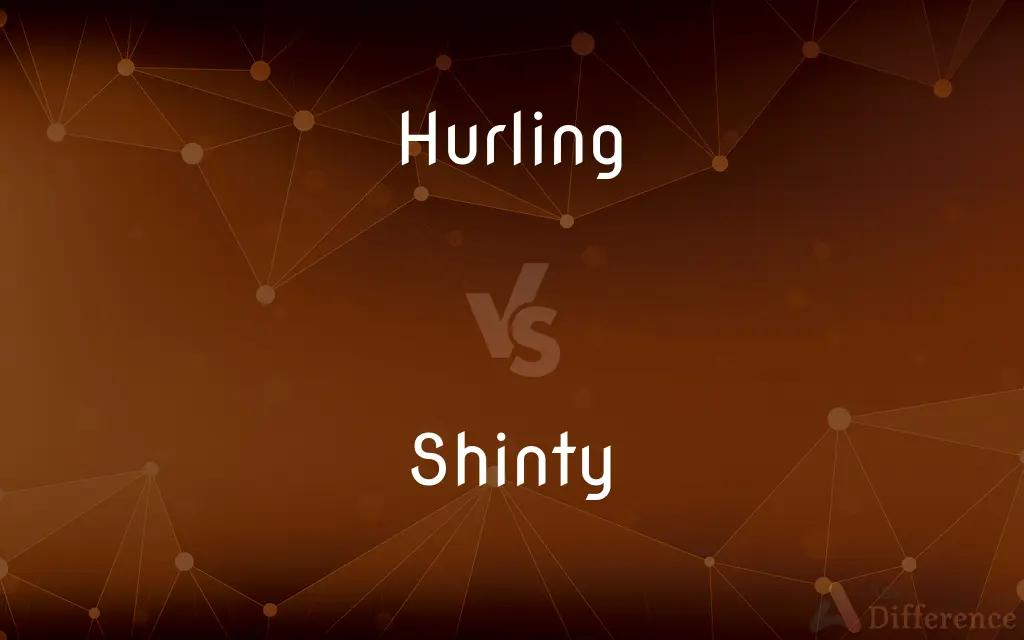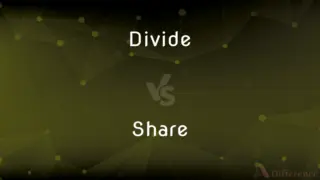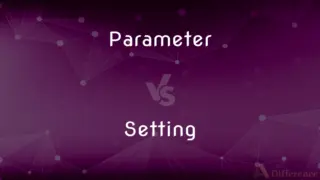Hurling vs. Shinty — What's the Difference?
By Maham Liaqat & Fiza Rafique — Updated on March 8, 2024
Hurling is a fast-paced Gaelic sport played with a small ball and a curved stick, focusing on both aerial and ground play, while shinty is a Scottish game with similar equipment but different rules, emphasizing ground play and physical contact.

Difference Between Hurling and Shinty
Table of Contents
ADVERTISEMENT
Key Differences
Hurling, an ancient Gaelic sport, is known for its speed and skill, played with a hurley (stick) and sliotar (ball). Players can catch the ball in the air and strike it on the ground or in the air, combining elements of lacrosse, baseball, and soccer. Whereas, shinty, closely related to hurling, is predominantly played in Scotland, featuring a caman (stick) and a ball, with more emphasis on ground strokes and a different set of rules regarding tackling and scoring.
In hurling, the ball can be hand-passed, hit through the air, or on the ground with the hurley, and players are allowed to carry the ball for a maximum of four steps before they must either balance it on the stick or pass it. On the other hand, in shinty, players primarily hit the ball along the ground, and the rules for carrying or handling the ball are more restrictive, with direct hand contact with the ball being limited to the goalkeeper.
The scoring system in hurling consists of two types of scores: points by sending the ball over the crossbar of the H-shaped goal and goals by getting the ball into the net, each goal equivalent to three points. In contrast, shinty's goals are scored only by hitting the ball into a net, without the option of scoring points by sending the ball over a crossbar.
Hurling matches are played on a pitch up to 145 meters in length, with 15 players on each team, reflecting its widespread popularity in Ireland. Shinty, while also played on a large field, can vary more significantly in team size, from 12 to 10 players, depending on the competition, indicative of its more localized popularity within Scotland.
Both sports have deep historical roots, with hurling traced back over 3,000 years in Ireland, making it one of the oldest field games in the world and an integral part of Irish culture and identity. Shinty, similarly ancient, holds a cherished place in Scottish Highlands culture, where it has been played for centuries, contributing to its local but fervent following.
ADVERTISEMENT
Comparison Chart
Origin
Ireland
Scotland
Equipment
Hurley (stick), sliotar (ball)
Caman (stick), ball
Play Style
Aerial and ground, fast-paced
Primarily ground, physical
Scoring
Points (over crossbar) and goals (in net)
Goals only (in net)
Player Movement
Can carry the ball for four steps
Limited ball handling, emphasis on striking
Team Size
15 players
10-12 players, depending on the competition
Field
Up to 145 meters in length
Varies, often similar in size
Historical Roots
Over 3,000 years, part of Gaelic culture
Ancient, integral to Scottish Highlands culture
Tackling Rules
Specific tackling techniques allowed
More physical contact allowed
Ball in Play
Can be played on the ground or in the air
Primarily played on the ground
Compare with Definitions
Hurling
Features a scoring system of points and goals.
The hurling team won by combining precise points with strategic goals.
Shinty
A Scottish game emphasizing ground play and physicality.
He excelled at shinty, skillfully maneuvering the ball on the ground.
Hurling
Has ancient origins in Ireland.
Hurling, with its rich history, is considered a cultural treasure in Ireland.
Shinty
Deeply rooted in the Scottish Highlands.
Shinty is more than a sport in the Highlands; it's a vital part of community life.
Hurling
A team sport with 15 players on each side.
Their hurling team practiced tirelessly, perfecting their coordination.
Shinty
Played with a caman and ball, focusing on striking.
Shinty players train to hit the ball powerfully with their camans.
Hurling
Known for its aerial play and speed.
The hurling match was exhilarating, with rapid exchanges of the ball in the air.
Shinty
Team sizes can vary, reflecting its local popularity.
The local shinty club, with its 12-member team, prepared for the regional competition.
Hurling
A fast-paced Gaelic sport played with a hurley and sliotar.
He showed exceptional skill in hurling, scoring three goals in one match.
Shinty
Scoring is achieved by hitting the ball into a net.
The decisive moment in the shinty match was the spectacular goal from midfield.
Hurling
Hurling (Irish: iománaíocht, iomáint) is an outdoor team game of ancient Gaelic Irish origin, played by men. One of Ireland's native Gaelic games, it shares a number of features with Gaelic football, such as the field and goals, the number of players and much terminology.
Shinty
Shinty (Scottish Gaelic: camanachd, iomain) is a team game played with sticks and a ball. Shinty is now played mainly in the Scottish Highlands and amongst Highland migrants to the big cities of Scotland, but it was formerly more widespread in Scotland, and was even played in northern England into the second half of the 20th century and other areas in the world where Scottish Highlanders migrated.While comparisons are often made with field hockey the two games have several important differences.
Hurling
An Irish game resembling lacrosse played with a broad-bladed, netless stick.
Shinty
A game derived from hurling, and resembling hockey, played in Scotland.
Hurling
The act by which something is hurled or thrown.
Shinty
The stick used to strike the ball in this game, similar to a hockey stick.
Hurling
An Irish game of ancient Celtic origin. It is played with an ash stick called a hurley (camán in Irish) and a hard leather ball called a sliotar.
Shinty
A Scotch game resembling hockey; also, the club used in the game.
Hurling
A Cornish street game resembling rugby, played with a silver ball.
Hurling
Present participle of hurl
Hurling
The act of throwing with force.
Hurling
A kind of game at ball, formerly played.
Hurling taketh its denomination from throwing the ball.
Hurling
A traditional Irish game resembling hockey; played by two teams of 15 players each
Hurling
Rushing and whirling;
The hurling water
Common Curiosities
Are hurling and shinty played professionally?
While there are competitive leagues, both sports are primarily amateur, with a strong emphasis on community and tradition.
Is there a mixed version of hurling and shinty?
Yes, there are composite rules games that allow teams from both sports to compete against each other, blending aspects of both games.
How old are hurling and shinty?
Both sports are ancient, with hurling being over 3,000 years old and shinty having centuries-old traditions in Scotland.
How does the scoring system work in hurling vs. shinty?
Hurling uses a dual scoring system with points and goals, while shinty scores are solely based on goals.
Can women play hurling and shinty?
Yes, both sports have women's versions, with camogie being the equivalent of hurling for women, and shinty also has women's teams and competitions.
Where are hurling and shinty most popular?
Hurling is most popular in Ireland, whereas shinty has its stronghold in the Scottish Highlands.
What is the main difference between hurling and shinty?
The main differences lie in their play style, scoring, and rules of play; hurling is faster with aerial play, while shinty is more grounded and physical.
Can hurling and shinty players compete in each other's sports?
While the skills in one sport can transfer to the other, the specific rules and play styles require adaptation by players.
What equipment is needed to play hurling or shinty?
Both sports require a stick (hurley for hurling, caman for shinty) and a specific ball for each game.
What's the significance of hurling and shinty in their respective cultures?
Both sports are deeply embedded in their cultures, representing more than just games by embodying historical, social, and community values.
Share Your Discovery

Previous Comparison
Divide vs. Share
Next Comparison
Parameter vs. SettingAuthor Spotlight
Written by
Maham LiaqatCo-written by
Fiza RafiqueFiza Rafique is a skilled content writer at AskDifference.com, where she meticulously refines and enhances written pieces. Drawing from her vast editorial expertise, Fiza ensures clarity, accuracy, and precision in every article. Passionate about language, she continually seeks to elevate the quality of content for readers worldwide.
















































